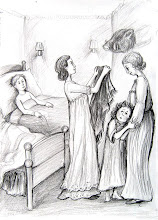.jpg)
Within this annotated bibliography, the particular focus we concentrated on was the narrative description of Lily’s creative process, specifically her mental activity while painting. As we read Woolf’s novel, To the Lighthouse, the narrative style provoked us to question the motive that Woolf had for presenting a story in the detailed and confusing way that she did. As a group we pondered if Lily’s character was in any way symbolic for the purpose Woolf felt drawn to fulfill. While spending many days puzzled with this inability to correlate the craftiness level that Woolf presented us with, we decided to formulate our research question around the similarities, if any, that Woolf portrayed as a writer and also brought forth in Lily as a painter. We felt that our ability to examine Lily’s creative process would enhance our understanding of Woolf’s narrative style and plot sequence.
The character of Lily Briscoe has been widely acknowledged to be modeled upon Virginia Woolf herself; through our research we discovered that Lily’s creative process closely mirrors Virginia Woolf’s writing style. By finding multiple sources that focused on the character of Lily and on the novel To the Lighthouse, as well as sources that concentrated on the life of Woolf and her own artistic process, we were able to better understand that Lily Briscoe is indeed an embodiment of the most important and most difficult elements of Virginia Woolf’s life. In essence, this aided us in understanding the form of Woolf’s narrative. Lily’s chaotic artistic process correlates with Woolf’s scattered, but exquisite emphasis on each person’s thoughts, which present a new way to view and portray characters and their relation to one another.
We feel that we have grown as readers through this experience, by having been pushed out of our comfort zone and allowed to experience the blissful, yet torment filled moments that Woolf created for our minds to be challenged. We also noticed that throughout the sources gathered there was a great deal of focus and energy spent showing how Woolf used her works to release some of her frustrations and the unpleasant memories that she carried within her. Woolf proved that women didn’t have to be just housewives and mothers, as was expected, but also successful artists. She did not allow the oppression that the male gender brought forth to phase her, which allowed her to persevere and conquer. Through this she influenced those around her while alive and even more so those that are privileged to read her works as the years and decades continue to pass. Woolf has accomplished, in our humble opinion, more than she ever imagined she could have.


